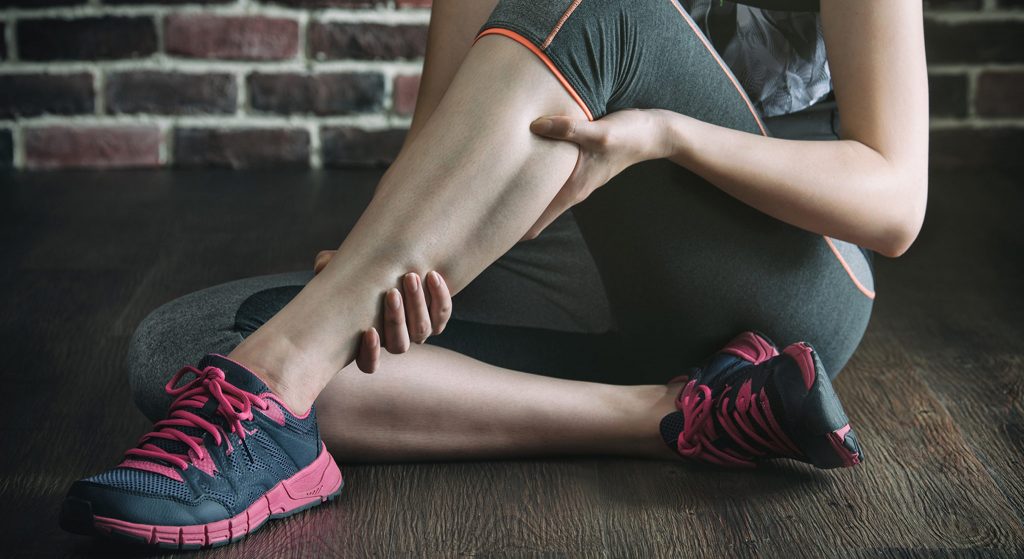Calf Tears: Management of Calf Strains
The calf muscles (gastrocnemius and soleus) run down the back of the lower leg from the back of the knee to the back of your heel. Injuries to the calf are common in sports involving running, acceleration or changes in direction such as football, basketball and hockey. Runners are at particular risk of calf tears as the muscles are a primary source of shock absorption and propulsion during running.
Tears to the calf muscle can range from a small partial tear whereby there is minimal pain and minimal loss of function, to the more extreme and rare complete ruptures which may require surgical intervention. Prompt treatment of a strained calf can help to speed recovery and minimise the symptoms.
What are the Symptoms of a Calf Tear?
- A sudden sharp pain or pulling sensation at the back of the lower leg during exercise.
- May feel like you have been hit in the leg and potentially hear a “pop”.
- May only experience the sensation of a deep recurrent cramp with activity that eases with rest.
- Pain on stretching the muscle.
- Difficulty walking properly or standing on toes.
- Inability to hop on the injured leg.
- Swelling and bruising may be present.
- If the rupture is severe a gap in the muscle belly may be felt.
Severity of Calf Tears:
Calf strains may be minor or very severe. Strains are broadly graded 1, 2 or 3 depending on severity, where grade 1 tears are low grade injuries within the muscle and grade 3 is a severe or complete rupture of the muscle.
Grade 1:
- The muscle is overstretched or overloaded beyond its capacity causing small micro tears in the muscle fibres.
- Mild discomfort, often minimal disability.
- Recovery takes approximately 2 to 3 weeks if you do all the right things.
Grade 2:
- There is partial tearing of muscle fibres.
- Moderate to severe discomfort with walking, and limited ability to perform activities, such as running and jumping.
- May have swelling and bruising associated.
- Full recovery takes approximately 4 to 6 weeks with good rehabilitation.
- Professional assistance is highly recommended.
Grade 3:
- This is the most severe calf strain with complete tearing or a rupture of muscle fibres in the lower leg.
- Severe injury that can cause inability to walk. Often patients complain of muscle spasm, swelling and significant bruising.
- Full recovery can take 3 to 4 months, and in some rare instances, surgery may be needed.
What is the Acute Management of a Calf Tear?
It is vitally important that treatment for a strained calf starts immediately following injury. The most important phase for treatment is the first 48 hours post-injury. Early management will have you back on the field faster. Suggestions for immediate treatment of a strained calf include:
- Stop your activity.
- Rest the injured leg.
- Use icepacks every two hours, applied for 10-15 minutes.
- Elevate the leg above heart height whenever possible.
- Avoid exercise, heat, alcohol and massage in the first 48 hours, as these can all exacerbate swelling.
Professional Help
If the pain from a low grade calf tear that you are managing yourself has not improved after a day or so, or it is a more severe grade 2 or 3 tear, it is best to seek medical advice and consult with one of our physiotherapists to get an accurate diagnosis of the injury and suggest the most appropriate treatment plan.
Physiotherapy Provides Rehabilitation and Support
Physiotherapy treatment will depend upon the severity of the injury. The success rate of treatment is largely dictated by patient compliance. Treatments may include:
- Hands on therapy for damaged tissues. Soft tissue therapy is excellent for reducing inappropriate scar adhesions while promoting faster healing conditions.
- A stretching program can be started as soon as the pain and swelling subside to encourage full range of pain-free movement.
- Management primarily involves rehabilitation and strengthening exercises to rebuild the strength of the injured muscle to prevent re-injury and to target overall leg strength.
- A lumbopelvic stability retraining program is highly recommended for improved load distribution.
- A progressive speed, agility and power program that prepares you for your sport is the best chance to ensure a successful outcome and full return to your pre-injury status.
- Correction of any predisposing biomechanical stressors (e.g. excessive foot pronation or rolling in) and muscle imbalances.
- Provide mobility aids such as crutches or walking boots where appropriate in the acute phase.
Inadequate rehabilitation commonly results in recurrent and more severe calf strains.
Preventing a Calf Tear
Suggestions to prevent calf strains:
- It is important to warm up appropriately before training or competition. This should consist of some light aerobic exercise followed by dynamic, sports specific drills, e.g. FIFA 11+ injury prevention program.
- One of the most important methods of preventing a calf tear is to increase the strength of the calf muscles. Consult with one of our physiotherapists for a suitable calf strengthening program. A calf tear is far more likely in athletes who have weak calf muscles that don’t meet the demands of their sport or activity.
- Adequate load progression with training/competition has been highly indicated for injury reduction, that is, not doing too much too quickly. Our physiotherapists can guide your training program to limit the effects of inappropriate load management.
- Include calf muscle maintenance in your workout routine (e.g. massaging, stretching, foam roller).
- Update footwear regularly as overused shoes can lead to poor biomechanics and foot posture.
If you would like further information on the management of a calf tear contact one of the physiotherapists at Jubilee Sports Physiotherapy.























